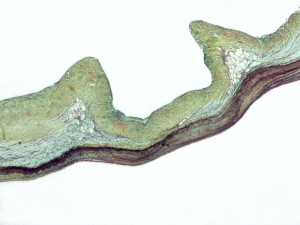Hill’s sign

Myxomatous aortic valve histology – a cause of aortic insufficiency
Click on image for an enlarged view
- Hills’s sign refers to the increased systolic blood pressure recorded in the lower limb in cases of aortic insufficiency
- Normally, the lower limb systolic blood pressure is 10-20mm higher than the upper limb pressure
- This is appreciated only when using the indirect method of blood pressure measurement (using sphygmomanometer)
- Direct blood pressure measurement using intra arterial probes do not show the pressure difference
Mechanism of Hill’s sign:
- The increased blood pressure is the result of summation of reflected pressure waves
- The lower limb vessels are more muscular compared to the upper limb vessels
- Also they are a direct continuation of the aorta unlike the upper limb vessels which arise at a 90 degree angle
- As a result, the pressure wave is transmitted at high speed in the wall of the lower limb vessels, gets reflected at the end and summates with the incoming wave
- This results in the apparent increase in lower limb blood pressure
What happens in aortic regurgitation?
- In aortic regurgitation, the increased momentum of ejection results in greater amplitude of the pressure wave
- Hence, the pressure wave summation effects are greater resulting in increased blood pressure difference
Grading of aortic regurgitation using Hill’s sign
| Severity of Aortic Regurgitation | Blood pressure difference (mm of Hg) |
|---|---|
| Mild | 20-40 |
| Moderate | 40-60 |
| Severe | >60 |
Image credits : Nephron
One Comment



What if I stand upside down on my hands ? won’t the reverse mechanism take place & vascular pressure will be higher in my upper arm vessels ?